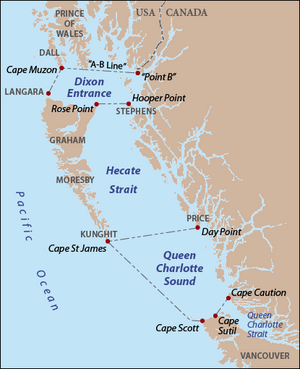Queen Charlotte Sound (Canada) facts for kids

Queen Charlotte Sound is a large area of the Pacific Ocean found in British Columbia, Canada. It sits between Vancouver Island to the south and Haida Gwaii (which used to be called the Queen Charlotte Islands) to the north. This sound connects with Hecate Strait in the northern part and Queen Charlotte Strait in the southern part. It's an important waterway for both nature and people.
Contents
Queen Charlotte Sound
Queen Charlotte Sound is a big body of water that acts like a gateway to many smaller islands and inlets along the coast of British Columbia. It's part of a larger system of channels and straits that make up the complex coastline of this region. The sound is known for its deep waters and strong currents, which are shaped by the tides and the flow of rivers into the ocean.
Where is it?
The sound is located off the west coast of Canada. To its south, you'll find the northern tip of Vancouver Island. To its north are the beautiful islands of Haida Gwaii. These islands are home to the Haida people, who have lived there for thousands of years. The sound also connects to other important waterways. To the north, it opens into Hecate Strait, which separates Haida Gwaii from the mainland. To the south, it narrows into Queen Charlotte Strait, leading towards the central coast of British Columbia.
What's Special About It?
Queen Charlotte Sound is a very important place for many reasons. It's a busy route for ships and boats, connecting coastal communities. It's also incredibly rich in marine life, making it a vital habitat for many different species.
Marine Life
The waters of Queen Charlotte Sound are home to a wide variety of animals. You can find many types of fish, including salmon and halibut. Marine mammals like whales, dolphins, and seals often swim through these waters. Different kinds of seabirds also live and feed here, making it a lively ecosystem. The rich nutrients in the water support a strong food chain, from tiny plankton to large predators.
History and People
For centuries, the coastal Indigenous peoples, including the Haida and Kwakwaka'wakw nations, have used Queen Charlotte Sound for travel, fishing, and trade. Their history and culture are deeply connected to these waters. European explorers later charted the sound, and it became important for fishing and logging industries. Today, it remains a significant area for both commercial activities and conservation efforts, aiming to protect its natural beauty and resources for future generations.
See also
 In Spanish: Sound de la Reina Carlota para niños
In Spanish: Sound de la Reina Carlota para niños

